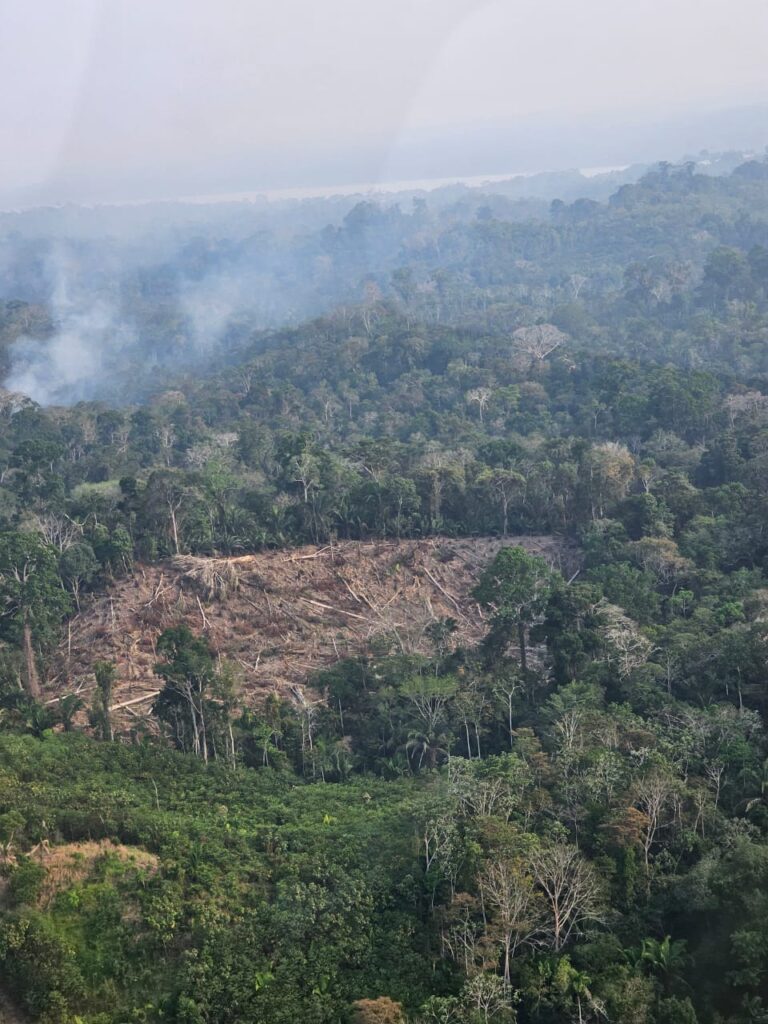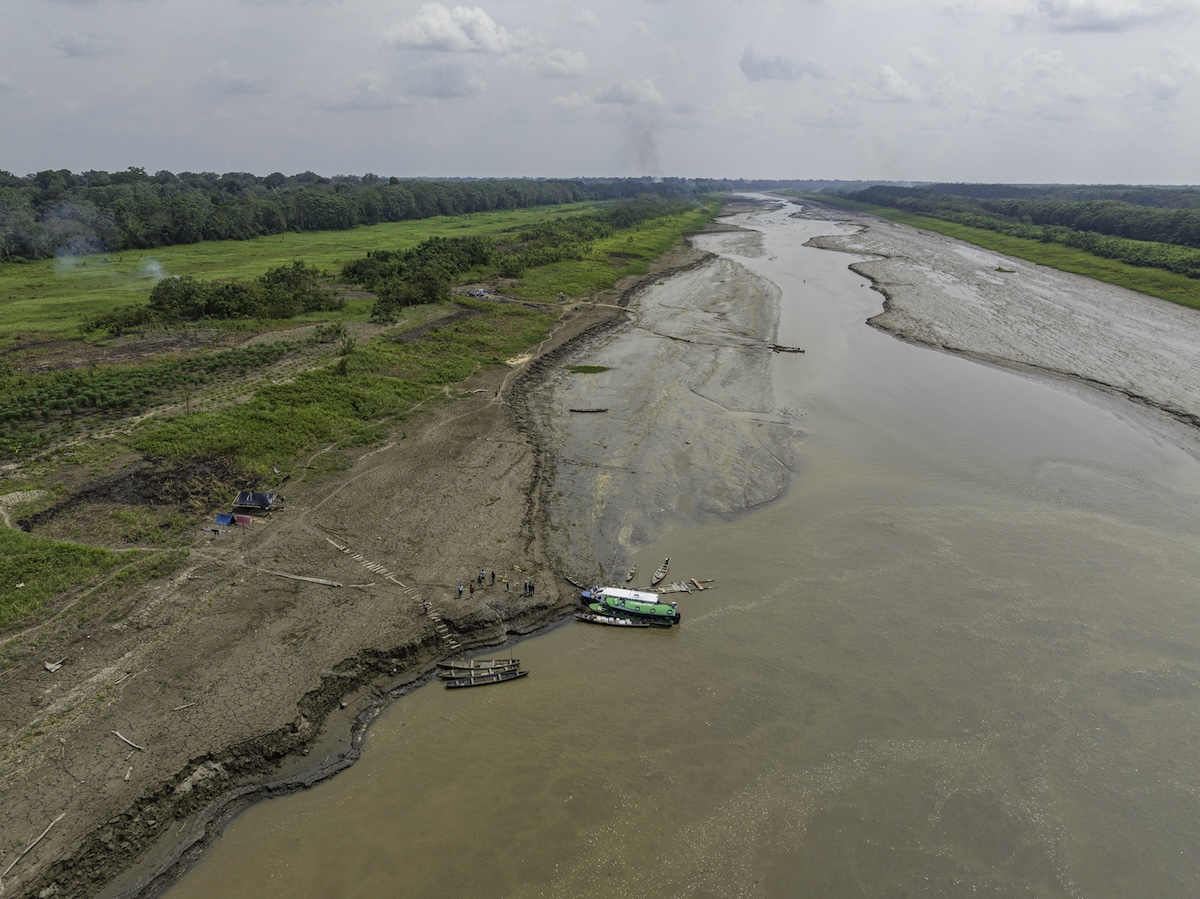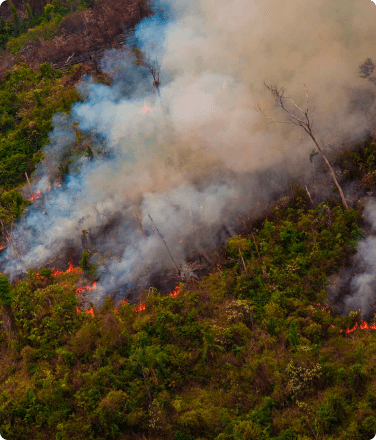- This year’s drought is on track to surpass the severe conditions of 2023, which left millions of Indigenous people in the Amazon isolated and struggling to access food and water.
- The climate crisis, fueled by deforestation and exacerbated by fires, is the main driver behind the escalating drought, impacting local communities – who have contributed the least to it.
- Securing land titles for Indigenous communities and effective community-led forest monitoring are crucial to curbing deforestation and protecting the rainforest.
Imagine struggling to access clean drinking water and food. Or being isolated, unable to travel for medical assistance. Millions of Indigenous people and local communities in the Amazon are dealing with this now as the region grapples with the worst drought in recent history—for a second year in a row.
The Amazon rainforest, home to one-fifth of the world’s freshwater, suffered a record-breaking drought in 2023. The drought isolated Indigenous communities who depend on rivers for transportation, limited their access to food and water, devastated wildlife, and pushed governments like Peru to declare a state of emergency. Now, 2024 is on track to be even worse, with water in rivers at critically low levels. [1]
“
”
The entire community is extremely impacted by this drought and we are still recovering from last year’s. We have never seen this type of drought before. We cannot consume the water, instead we have to buy water because we don’t have access to wells. The water in the rivers is so hot during the day that it’s not even suitable for bathing and we have to wait until nighttime for it to cool down.
- Gadiel Fernando Pereira,
Community Monitor of the San Miguel de Cacao Community, Loreto, Peru
This drought is the worst in four decades and is contributing to an alarming number of fires this year raging across multiple regions throughout the Amazon and posing a threat to Indigenous and local communities and some of the world’s most vital ecosystems. Officials report that Brazil is now home to about 60% of all active fires in Latin America. Over 50,000 fires are currently burning in Brazil, with the Amazon, Cerrado, and Pantanal among the hardest-hit areas. According to MapBiomas, approximately 13.34 million acres of land were destroyed there between January and August, an area larger than Costa Rica. [2]
Forest fires, once primarily limited to the Brazilian and Bolivian Amazon, have now become a significant concern in the Peruvian Amazon, which is facing an unprecedented crisis: 3.411 fire alerts have been recorded through September 21, 2024, according to the Global Forests Watch dashboard. This figure is 32% higher than what was detected during the same period in 2023. Although there are still three months remaining this year the number of alerts has already surpassed those from all of 2023 (3,331) and 2021 (3,336). Additionally, there has been a 62% increase in the area of forests affected by fires in 2019 compared to that of 2023. [3]
The fires have destroyed soils and forests, severely impacting regions such as Cajamarca, Amazonas, San Martín, and Ucayali. These fires come at a time when Peru lacks a fire prevention and risk reduction plan, something they have not had since 2022.

Beyond the destruction of forest cover, the human toll is also significant. As of September 22, the National Civil Defense Institute (Indeci) reported 18 deaths and nearly 165 injuries due to the fires, which have been recorded in 22 regions of Peru.
A Climate Emergency
The drought is a direct symptom of climate change. Recent research shows that while El Niño, a natural weather phenomenon responsible for reduced rainfall contributes to drought conditions, climate change remains the primary cause. [4] The crisis is further intensified by ongoing deforestation that severely reduces the rainforest’s ability to retain water. The rise in rainforest fires, often linked to slash-and-burn practices by cattle ranchers and soybean producers, compounds the problem as hotter and drier conditions increase the forest’s vulnerability to flames spreading and burning vast tracts of pristine native forest. These combined factors are driving the Amazon towards its tipping point and are a stark reminder that Indigenous peoples, who contribute the least to climate change, bear the brunt of its impacts.
“
”
This year we have seen the Amazon dry up to an extent we’ve never seen before due to deforestation. So much of the land has been destroyed by outsiders that have severely damaged our territory, our forest–and we are suffering the consequences… We don’t know what will happen to us next year. I imagine that it is going to be harder and that is why we need to prevent the impacts of climate change.
- Apu Francisco Hernández Cayetano, President of the Federation of Ticuna and Yahuas Communities of Bajo Amazonas (FECOTYBA)
The Power of Indigenous-Led Forest Protection
Peru’s Indigenous peoples safeguard nearly a quarter of the Peruvian Amazon, and it is well-documented that their unparalleled knowledge of the land makes them the most effective stewards of the rainforest. And healthy rainforests don’t burn. Yet, many Indigenous peoples remain without the legal recognition of their ancestral territories—leaving communities and the land vulnerable to those who seek to destroy the rainforest for profit. With deforestation as the second leading cause of carbon emissions, it is crucial to equip Indigenous peoples, who are on the frontlines of rainforest protection, with the resources needed to defend their territories. [5]

Land titles are one of the most effective ways to reduce deforestation on Indigenous peoples’ territories. In a defining moment for the rights of Indigenous peoples in Peru, 37 land titles were secured in the Amazon in record time, from June 2023 to May 2024. This achievement was made possible through an innovative and collaborative approach between the Interethnic Association for the Development of the Peruvian Rainforest (AIDESEP), the regional government of Loreto, and Rainforest Foundation US (RFUS). Our partnership, grounded in Indigenous leadership and supported by advanced technology, provides a scalable model for protecting territories and defending biodiversity.
These titles present an important milestone in the fight for Indigenous peoples’ autonomy and against the climate crisis—ensuring that these lands remain under their stewardship in perpetuity. In addition to land rights, effective forest monitoring is critical. RFUS’s Rainforest Alert program provides Indigenous communities with the tools, training, and financial support to map, monitor, and secure their territories using technology like smartphones and drones. This community-led initiative is fundamental to keeping illegal deforestation off Indigenous peoples’ lands.
Unified Action for the Road Ahead
“
”
If extreme drought continues, what will Indigenous communities have to endure in a decade from now? Global and local support for Indigenous peoples’ land rights and forest monitoring are imperative to mitigate the harshest impacts of climate change.
- Gina Ruiz-Caro Rothgiesser,
RFUS’s Western Amazon Director
We need collective action to address the climate emergency unfolding in the Amazon rainforest. While communities continue to fight for their lands, the impacts of the climate crisis show no signs of slowing. The evidence is clear: Without unified support to safeguard Indigenous peoples’ land rights, the Amazon and our global climate will be pushed to the brink. The rivers of the Amazon are more than waterways—they are the lifeblood of one of the most vital ecosystems on planet Earth. All of humanity depends on their continued flow.
Notes
- NBC News, “Severe drought has returned to the Amazon. And it’s happening earlier than expected,” August 3, 2024.
- MapBiomas, “Agosto responde por quase metade da área queimada no Brasil em 2024,” September 13, 2024.
- Ojo Publico, “Bosques y suelos arrasados por incendios forestales en Perú crecieron más de 60% en cuatro años,” September 22, 2024.
- World Weather Attribution, “Climate change, not El Niño, main driver of exceptional drought in highly vulnerable Amazon River Basin,” January 24, 2024.
- Live Science, “Deforestation: Facts, causes & effects,” April 28, 2023.



